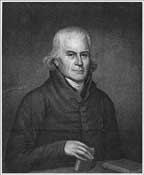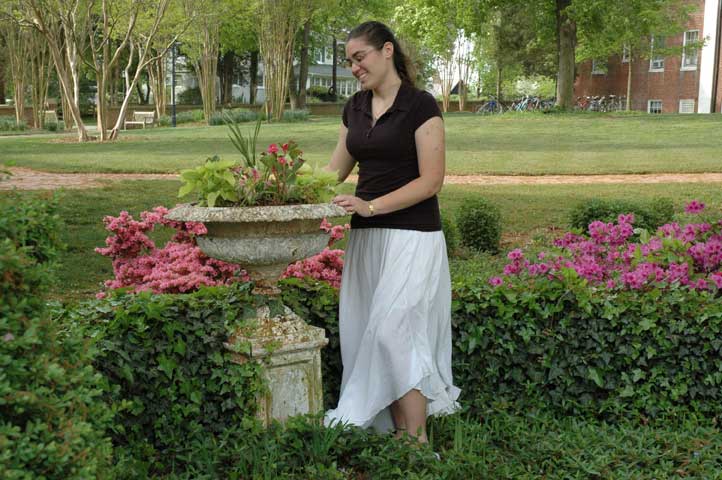 RIVER
GAZETTE
RIVER
GAZETTE
Fall, 2009
Student Tackles 1795 Arson Case
Did a Pastor Burn Down the College?
Written by Bonnie McCubbin '09
Friday night, December 7, 1795, was cold and dark.
There had been hard frosts for several days prior, so snow was likely on the ground at the
time and the weak moon was just a sliver. Cokesbury College in Abingdon, Maryland, was
deserted as the first flames licked at the wooden siding.
 Once a boarding school, the world's first Methodist college quickly burned to
the ground in an act of arson believed to be religiously motivated.
Once a boarding school, the world's first Methodist college quickly burned to
the ground in an act of arson believed to be religiously motivated.
The Methodist Quarterly Review describes the events of the night:
Mr. Everett, the chaplain to the college, who slept there for the safety of the
property, had gone, on the morning of the 7th of December, 1795, into the country to see
some friends, when, at twelve o'clock at night, the inhabitants [of the town] were roused
by the cry of the college being on fire. Nothing could be done to arrest the flames. In a
few hours the stately edifice, with its valuable contents, consisting of the library, the
philosophical apparatus, and many important private papers, was reduced to ashes. News of
the unfortunate event was conveyed to Mr. Everett, who appeared on the spot early the next
day, the picture of grief, and sat down near the ruins, and wept like Marius amid the
desolations of Carthage.
The governor of Maryland, John Stone, offered a sizeable reward of $1,000 for the
apprehension of an arsonist, but no one was ever caught and to this day the crime has been
unsolved. Methodists at the time claimed that they knew who the arsonist was, but the name
was never recorded .... or was it? For two years I delved into archaeological and
historical records, but it was an obscure statement in a letter by the founder of the
institution, Francis Asbury, to a colleague in New York 14 months after the fire that led
me to who Asbury claims is the identity of the arsonist.
Cokesbury College, created by clergy at the Christmas
Conference of 1784, was located on the main post road between Baltimore and Philadelphia
because Maryland housed over one third of the nation's Methodists. It was a pioneering
institution designed to serve the needs of the sons of itinerant preachers, benefactors
and orphans. While it was the third college established in Maryland, Cokesbury had the
first manualtraining school in America. The school officially opened in 1787. Methodist
clergy, according to author James Edward Armstrong, would retreat to Cokesbury each year
to escape the foul air of Baltimore.
By 1792, according to records, the Maryland General Assembly agreed to grant an act of
incorporation to the college so it could confer degrees with the stipend that Cokesbury
transfer out of the control of the Methodist Church and into the hands of a
"secular" - that is, multi-denominational-board of trustees. By 1793, the school
had a debt of $6,000, but was still incorporated by the end of 1794. One year later, the
institution burned down.
While natural and accidental causes are theoretically possible, based on the evidence
presented archaeologically and historically, neither seems likely. On February
11,1797, Bishop Asbury wrote a personal letter to the Rev. George Roberts, a pastor in New
York City. In this letter, he speaks of several things, including the burning of Cokesbury
College and the schism by a dissident Methodist pastor named James O'Kelly. O'Kelly had
issues with the authority, power, and control the bishops, namely Francis Asbury, had over
the church and clergy. Records show many dialogues between the Methodists and O'Kelly, who
ultimately broke away from the Methodist Church to form his own denomination-the
Republican Methodists.
In the letter, Asbury makes mention that "It seems the temple of war on James is shut
up," suggesting that some of the issues with the O'Kellyites had been taken care of
at this point-that perhaps James O'Kelly and his fellow dissidents were not raising any
new issues of contention. The letter goes on: "Brother James O'Kellyanswered a woman
who asked the difference between me and him. He gave her the powerful return ‘Suppose
I were to show you the Bible and a form of discipline made by the General Conference,
would you not know the difference?'" The accusation that Asbury did not follow
scripture and instead obeyed earthly teachings is striking, and helps to confirm the
hatred and animosity that O'Kelly felt for Asbury.
 Thus, O'Kelly had the motive to burn Cokesbury College, which he believed to
be a rigid institution that embodied everything the Methodist Church, and Francis Asbury,
stood for. Burning Cokesbury would be equivalent to personal revenge on Asbury. The proof
of this comes from the end of Asbury's letter to Roberts when he states,
Thus, O'Kelly had the motive to burn Cokesbury College, which he believed to
be a rigid institution that embodied everything the Methodist Church, and Francis Asbury,
stood for. Burning Cokesbury would be equivalent to personal revenge on Asbury. The proof
of this comes from the end of Asbury's letter to Roberts when he states,
As to the Baltimore burning, after a little shock
at first it seems no more to me than as much chaff. If the LORD loves these people he will
keep them down. Burning is a lottery, and many make a benefit of the calamity which I
suppose is one. I only wish to know who burnt Cokesbury, which I shall ever believe was
done wickedly, and I am sure it will come out at the day of Judgment. I have written
circumstantially, I am weak.
Dissecting this passage, several things emerge.
First, Asbury admits that he is not being upfront with his writing-he claims that he is
too weak [hearted] to directly accuse the arsonist. He could also have been afraid of
repercussions if the letter were intercepted by a third party. But, by putting his clues
together, the reader can ascertain who Asbury believed the arsonist was, and solve the
riddle that Asbury wove.
"Chaff," as the letter states, is the outer shell or husk that must be removed
to access the valuable grain inside. It is removed by a process called threshing and
winnowing, whereby, after the plants were cut, they were crushed, and then the pieces were
thrown into the air. Chaff is light and is carried away by a slight breeze, but the good
grain falls back to the earth.
Asbury knew his scriptures well, and was alluding to Psalm 1 which compares wicked men to
chaff that the wind blows away. The key verses are 4-6: Not so the wicked! They are like
chaff that the wind blows away. Therefore the wicked will not stand in the judgment, nor
sinners in the assembly of the righteous. For the LORD watches over the way of the
righteous, but the way of the wicked will perish.
Understanding this leads to the interpretation of Asbury's quote that the college burning
was useless, like chaff, because it would not achieve anything. God loves the Methodists,
he is saying, and will keep them down like good grain-wellgrounded, nourishing,
life-giving. By piecing the clues together, O'Kelly, considered wicked by Asbury, was
useless, and would perish-like chaff. Chaff is symbolic of a faithless life-able to be
blown away by the slightest breeze; whereas good grain is symbolic of a faithful
life-well-grounded, and sustains life.
The clues add up: motive, opportunity and desire. I do not claim conclusively that O'Kelly
burned down the church, but I do claim that Asbury believed he did. We have Francis
Asbury's own words: James O'Kelly is the arsonist who burned Cokesbury College.
Author Bonnie McCubbin
 This article, which tracks the
mystery arsonist who burned down a college in Harford County, Maryland, 200 years ago, is
adapted from a senior thesis written by St. Mary's College grad Bonnie McCubbin '09.
McCubbin presented her results last spring on campus, at the Phi Alpha Theta regional
history conference at Millersville University, and at Cokesbury Memorial United Methodist
Church, which stands adjacent to the site of the burned college.
This article, which tracks the
mystery arsonist who burned down a college in Harford County, Maryland, 200 years ago, is
adapted from a senior thesis written by St. Mary's College grad Bonnie McCubbin '09.
McCubbin presented her results last spring on campus, at the Phi Alpha Theta regional
history conference at Millersville University, and at Cokesbury Memorial United Methodist
Church, which stands adjacent to the site of the burned college.
"Although Bonnie's senior project focused on what may seem like a longago
"who-dun-it," her fi ndings have far larger implications, not just for church
history, but for the history of the relationship of religion and education in a brand new
nation," says Julia King, St. Mary's associate professor and McCubbin's adviser.
An anthropology and history double major and math minor, McCubbin, of Bel Air, Maryland,
is now pursuing a master's degree at Wesley Theological Seminary in Washington, D.C., and
aspires to become an ordained elder in the United Methodist Church.